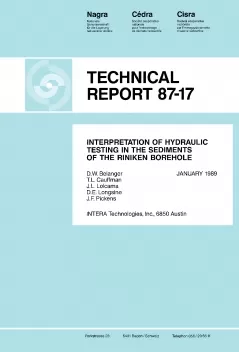
Technical Report NTB 87-17
Interpretation of hydraulic testing in the sediments of the Riniken borehole
The results of the hydraulic testing program in the Riniken borehole are presented as a summary of interpreted hydraulic conductivity, formation pressure, and equivalent freshwater head. Hydraulic tests were completed in 22 separate intervals in the Permian, Triassic and Jurassic sediments intersected by the borehole. Riniken was drilled to 1800.5 m apparent depth and tests were conducted in either single packer configuration, double packer configuration, or open borehole. A discussion of the testing techniques used in the borehole and the test interpretation approach is also presented along with estimates of equipment-related uncertainty on equivalent freshwater head values.
Testing was completed using either slug injection or withdrawal, pulse injection or withdrawal, drill-stem, or continuous pumping methods. Analytical solution and graphical (Horner) techniques were utilized for determining hydraulic conductivities of the tested formations. Where the test results were influenced significantly by a pressure disturbance around the borehole and/or thermal effects in the test interval, the INTERA Graph Theoretic Field Model (GTFM) was used to simulate the measured pressure responses.
Undisturbed fluid pressures in the tested formations were estimated for 6 test intervals by simulating the measured recovery to a static pressure or through the Horner method of drill-stem test analysis. Two additional formation pressures were determined from static water levels after testing in the open borehole. The equivalent freshwater heads, determined from formation pressure at the test interval or formation center, ranged from 460.4 m asl at 515 m below ground surface in the Schilfsandstein to 360.6 m asl at 1100 m below ground surface in the Permian. Ground surface datum at Riniken is 385.07 m.
The eight tests which provided freshwater heads were analyzed for uncertainty in head due to measurement errors of the various monitoring devices used. For two tests, the uncertainty of equivalent freshwater head for the water level tests is primarily caused by an uncertainty in fluid density. The head uncertainty for the other six tests is predominantly due to the accuracy specifications assumed for the pressure transducer P2. If the uncertainty range is defined by ± 2 standard deviations, the average uncertainty at the Riniken borehole is 3.1 m. It should be emphasized that this uncertainty is based only on measurement error and that other sources of uncertainty such as estimation of representative formation pressures from data interpretation are not treated.
Hydraulic conductivities were estimated for 19 of the 22 intervals tested, covering about 40 percent of the Riniken borehole length. Interpreted hydraulic conductivities ranged from 2.0E-14 ms-1 to 1.5E-06 ms-1. Hydraulic conductivities greater than 1.0E-09 ms-1 were obtained for 5 zones corresponding to the following tested apparent depths in the borehole: 500.99 – 530.50 m, 617.30 – 696.00 m, 793.00 – 820.20 m, 958.40 – 972.50 m, and 977.00 – 1009.95 m. The first three of these zones tested the Schilfsandstein, Upper Muschelkalk and Buntsandstein, respectively. The latter two zones were located in the upper Permian.
The range of specific storages used for the Riniken sediments was 9.4E-06 m-1 to 3.2E-07 m-1. Lower specific storage values were chosen for carbonate rocks and anhydrite, and the higher storage values were used for sandstones of the Rotliegendes.
The measured borehole temperatures determined using the hydrologic test tool ranged from about 22°C at 217 m through 63°C at about 1513 m apparent depth. A bottom hole temperature was not available from hydraulic testing because the bottom hole testing configuration placed the temperature sensor at 1500.5 m above the bottom of the borehole. The temperature increases with depth in the borehole at a gradient of about 3.9°C/100 m, based on measured temperatures during testing and high resolution temperature logging results.
